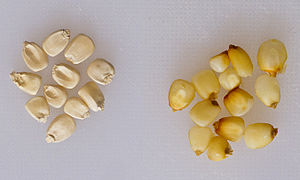|
|
| English: Corn before being treated with lime, and after boiling 15 minutes in lime (, 1 pound of corn for 1 tablespoon of lime, boil 15 minutes, let soak for a few hours, then wash). These are then ground for tortilla flour. (Here the hulls have not been yet removed, but should be after treatment). Español: Maíz, crudo (izq), y maíz, después de hervir por 15 minutos en agua y cal , 1 libra de maíz y 1 Cda de cal en agua, cocinar 15 minutos, dejar por unas horas, y lavarlo bin). (Photo credit: Wikipedia) |
Homemade Nixtamal (Corn Masa) (makes about 1-1/4 lbs. of dough) •1/2 lb. dried corn (about 1-1/2 cups) •1 cup wood ash (make sure the ash does not contain potentially toxic impurities, i.e., construction waste, etc.) or 2 Tbs. pickling lime (calcium hydroxide) •2 quarts water Rinse the corn well with cold water, then put it in a large, heavy pot (it will expand by three or four while cooking). In another pot, combine the wood ash or lime with the water and bring it to a simmer. If using ash, put the hot ash-water through a fine strainer, a dish towel or several layers of paper towels to remove the ash. Pour the strained ash-water or the lime-water over the corn. Bring the corn to a simmer; the skin of the kernels will turn bright yellow from the alkali in the water. Simmer the corn until the skin begins to loosen from the kernels - this can take anywhere from 1/2 hour to 2 or 3 hours, depending on the corn. Turn the heat off and cover the pot with a lid. Leave the corn sitting in the liquid for 8 hours or overnight; it will continue to soften. Drain the corn and rinse it in several changes of cold water to remove all traces of the cooking liquid. As you rinse the corn, rub it between your hands to remove the skin from the kernels. Some people also remove the “eye” of the corn, the tough pedicel at the top of the kernel, especially if they are trying to make a very smooth masa suitable for tortillas (it’s all right if tamale masa is fairly coarse). The cleaned kernels can be ground at this point to make a wet nixtamal to use immediately or freeze. The kernels may also be spread on a screen to dry and store for later use. If making masa, grind the kernels in several small batches in a food processor. The dough should be fairly homogenous, but will be a little coarse, good for tamales and hot chocolate, but not so great for tortillas. For fine nixtamal suitable for tortillas, you will need to grind the corn with a good quality corn mill or a metate (a traditional grinding stone). Note: Fresh masa can also be made using dried white hominy, (hominy is corn that has already been nixtamilized) available from the Spanish section in the supermarket. Though you won’t need to remove the skin from the kernels, you may want to cook them in ash or lime-water anyway (see the recipe above) just to imbue them with the distinctive flavor the alkaline solution creates. Whether you use ash/lime-water or plain water, simply cook the hominy until it is tender (about an hour) then rinse it well in cool water and proceed as above.
Patent: Patent application title:
Quick Corn Nixtamalization Process







6 comments:
Tortillas were prepared by first soaking the shelled corn in an alkali solution...next grinding the corn into a four on a metate or grinding-stone; then, shaping tortillas by hand; and finally, cooking them on a clay griddle called a comalli. Instruction in tortilla-making was one of the fundamental lessons mothers taught their daughters...Tortillas could be eaten fresh from the griddle, or they could be stored for later use, including meals eaten away from home by farmers, merchants, soldiers, or other travellers.
Tortillas were prepared by first soaking the shelled corn in an alkali solution...next grinding the corn into a four on a metate or grinding-stone; then, shaping tortillas by hand; and finally, cooking them on a clay griddle called a comalli. Instruction in tortilla-making was one of the fundamental lessons mothers taught their daughters...Tortillas could be eaten fresh from the griddle, or they could be stored for later use, including meals eaten away from home by farmers, merchants, soldiers, or other travellers.
Nixtamalization an excellent video about the foods of americans.
Cooking Issues has your bible. A pretty amazing post.
Industrial lime-cooking
Equipment for processing raw maize into lime-treated maize and then into a dough and tortillas was developed and industrial production of tortilla flour began in Mexico and other countries. Mechanized production in Mexico became important soon after the Second World War. Two types of industry are found in urban areas. One is the small family-owned home tortilla industry, where the process is as described above but with larger and mechanical equipment used to supply a larger market. This development became possible through the introduction of rotary mills and the tortilla maker designed by Romero in 1908. This equipment was later replaced by a more efficient type in which the dough is passed through a rotating metal drum where it is cut into tortilla shapes. These fall onto a moving belt or continuous cooking griddle, dropping into a receptacle at the end of the belt. This small industry may use whole maize, in which case the dough is cooked in large receptacles, or it may start with industrial tortilla flour.
Alkali cooking also improves product flavor and niacin availability. Niacin generally occurs in a bound
form in unprocessed corn (non-alkali treated) and is unavailable to single-stomached animals like humans.
Post a Comment